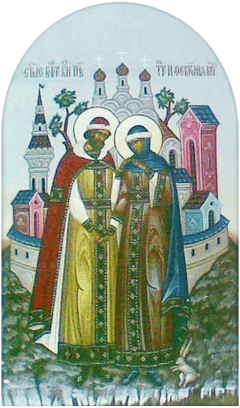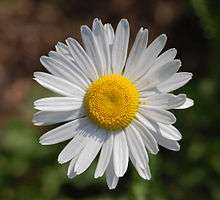Peter and Fevronia Day
| Peter & Fevronia Day | |
|---|---|
 mural St. Duke Peter and St. Fevronia of Murom | |
| Observed by | Russia |
| Type | Cultural, Orthodox |
| Significance | Love and Fidelity celebrated between marrieds |
| Observances | Sending greeting gifts and flowers (oxeye daisy) |
| Date | July 8 |
| Next time | 8 July 2017 |
| Frequency | annual |
The Day of Saint Peter and Saint Fevronia (Russian: День Святых Петра и Февроньи / Den' Svyatyh Petra i Phevronii) also known as the Day of Family, Love and Faithfulness (Russian: День семьи, любви и верности / Den' sem'i lyubvi i vernosti), the Orthodox patrons of marriage, was officially introduced in Russia in 2008. Svetlana Medvedeva is among the most active promoters of the new holiday. Its symbol is a white daisy.
History
The Day of Saints Peter and Fevronia since the days of Kievan Rus and until 1917, was broadly celebrated in Russia because it was believed that the saints Peter and Fevronia are the patrons of marriage and family, as well as the symbols of love and fidelity. On this day it was common to go to church, where the people asked for love and family grace.
The Tale of Peter and Fevronia of Murom (which literary treatment relates to the period of the mid-16th century), Duke Peter was the second son of Duke Yuri Vladimirovich of Murom. He ascended the throne in 1203. A few years before Peter’s principality he became seriously ill that no one could cure him. One day the duke had a dream that he can be healed by the girl Fevronia.
Fevronia (Greek Φεβρωνία) was beautiful, pious and good, plus she was a wise woman, she knew the properties of herbs and could cure ailments. The prince fell in love with Fevronia and vowed to marry her after the healing. The girl cured the duke but he did not keep his word. Then again he was defeated by the disease and Fevronia cured him once again. And this time the duke married the girl.
After the death of his brother Peter inherited the throne. The nobles (or boyars) respected his duke, but the haughty the nobles’ wives disliked Fevronia, not wanting to be ruled by the peasant. The nobles demanded that the duke had left her. Peter, after he heard of the intentions of separating him from the beloved wife, chose to voluntarily relinquish the power and wealth and go with her in exile. So Peter and Fevronia left Murom.
Soon the unrest began in Murom, nobles were quarreling, fighting for the throne. Then they came around, gathered a council and invited the duke and his wife back. The duke and duchess returned and Fevronia managed to earn the love of the urban counterparts. They ruled after that long and happily.
In his declining years, Peter and Fevronia took the vows in various monasteries and asked God to die in one day. They bequeathed to bury them in a specially prepared coffin with a thin partition in the middle.
Peter and Fevronia died each in his cell in a one day and hour – on 8 July 1228. But people have recognized the wicked to bury the monks in one coffin and have broken the will of the dead: their bodies were placed in the different realms. But the very next day they were found together. Twice their bodies were carried out to the different churches, but twice they miraculously were found side by side. And the spouses were buried together in the city of Murom at the cathedral church of the Nativity of the Blessed Virgin.
Since that time the history of the spouses of Peter and Fevronia is the embodiment of the unquenchable love and loyalty and every year on 8 July the Orthodox Church celebrates the memory of Saints Peter and Fevronia.

Controversy
The two saints feast day is like the Orthodox antipode of the Roman Catholic feast of couples in love – St. Valentine. Part of St. Valentine’s relics was deposited in the Cathedral of Christ the Saviour in Moscow several years ago, during the life of late Patriarch Alexiy II.
According to a recent opinion poll, St. Valentine's Day has become popular among Russians, yet this holiday has more opponents than supporters. Some Russians said's “our culture does not benefit from foreign holidays” or "it is a commercial holiday: not for people but for merchants".
According to sociological data, the demand for flowers, souvenirs and perfume in Russia grows by almost 15% ahead of All Lovers’ Day. At the same time, statistics shows that the number of those who mark All Lovers’ Day becomes smaller every year. This may be explained by the fact that the Russian Orthodox Church introduced its own lovers’ day in 2008.
References
- "История древнерусской литературы". Курс лекций; compiled by В.В. Кусков, 2 ed., Высшая школа, — М.: 1966. pp. 139–143.
- "Повесть о Петре и Февронии Муромских в её отношении к русской сказке. Скрипиль М.О. ТОДРЛ vol. 7 М. — Л. 1949.
- Православие и праздник 8 июля
- Всероссийский день семьи, любви и верности
- Russia marks the Day of Family, Love and Faithfulness
- Russians Still Can't Decide About St. Valentine's Day